
Wine Culture and Information since 2002 - Volume 22
 Wine Culture and Information since 2002 - Volume 22 |
|
Issue 87, Summer 2010 |
Contents |
|
|
Around Wine |
|
We have written so many times wine is more than a beverage. Since the beginning of its history, wine represented more than a beverage. Ritual, social, religious and cultural meanings, wine has accompanied the history of man along his journey. To tell the truth, it was not the only beverage to play this role: we may think about tea or beer, for example. A beverage for the connoisseurs, even expensive and destined to few ones, wine continues still today to play an important role in the life of men. Certainly changing form and context, but its “social” role does not seem to be changed much. In recent times it has become subject of debates, sometimes reaching the limit of an argument - although verbal - among many lovers of the beverage of Bacchus. Around wine there is however a lot more, beginning from the passion and commitment of many producers, who support their territory, their grapes, their wines. Writing about wine has also given birth to some sort of schools of thought, strong and indisputable positions, untouchable dogmas to the limit of a “daring offense”. Experts - or so called ones - express their opinion about wine, its quality, praising or literally destroying this or that wine, sometimes also with no significant cause. Of course, anyone has the right - full and indisputable - of expressing his or her opinion, right or wrong: this is an essential and fundamental principle as well as absolutely right. This principle is also valid for the right of criticism, that is the constructive and motivated expression of a thought, even in case - and event better - when it is negative and offered with the intent of giving a different point of view. When the criticism is the firm position of the one expressing it, without giving other a chance for an exchange of ideas and the sincere discussion, while ideally stepping up into the pulpit pronouncing sentences, hiding behind the cowardice a high position can ensure (but miserably low) shielded from rejoinders, this is nothing more than proving one's stupidity and lack of intelligence. Criticism is also a matter of respect and dignity. Respect for ourselves, because by expressing what we do not really think, just for pleasing others, is first of all a hypocrite act towards ourselves and then towards others. Respect for the ones producing a wine and making this with passion, using resources and life in something they believe into. And this should be respected, even when - and first of all - when we do not agree on it. Of course, not all producers are involved in making wine at the same way: for some it is just a secondary activity in order to get profits to be added to other primary activities having nothing in common with wine. In other words, it is just business. Last, but not the least, respect for the ones who read or listen to a criticism or an opinion. It is just playing a part in a stage: without the audience, the actor has no reason to perform in a stage. For this reason it must be sincere, honest and credible in what he or she is trying to communicate, otherwise receives only disapproval and dissent. And every real actor knows how important and fundamental is the respect for the “ones in front of the stage”. Theater: a magnificent school of life. Then there is the tale told by the ones making wine. Of the passion of seeing vines renewing every year the miracle of the genesis of bunches, of the ripening process under the sun. Therefore harvesting, the extreme sacrifice of grapes in order to give wine to men. Scottish writer Robert Louis Stevenson said “wine is bottled poetry”, and wine certainly is the poem of earth, made of verses told by Nature, words with a profound meaning, expression of a territory and its grapes. Poetry, prose, tales and songs, painting and sculpture: artistic expressions of the talents of men and in which wine has always been represented, sign of its importance in the life and feelings of men. Wine is the encounter of men with nature, a mutual collaboration where each element and each talent find their expression in aromas and flavors, therefore in sense, in those extraordinary means connecting the reality of world with the deep inner of men. There also are less noble and presumptuous expressions of wine, even annoying ones. Not because of wine fault, but for what they make about wine or would like to make of it. Sometimes wine is subject of élitism, of something offering the opportunity to showing off vanity, to emphasize a social or cultural difference, also humiliating, between the ones who believe to know wine and the ones who candidly and honestly admit to know wine a little less. For many, showing off the knowledge of certain names, expensive labels, famous grapes, represent the idiot occasion of appearing with no other mean, to have others believe they belong to a high social and cultural class, where wine represents a status symbol. All this in order to give the idea of being competent and “committed”, so obsessed in hiding to others and to themselves the nothingness they are. Wine is also a cause of discrimination: when someone talks to such persons while expressing indifference or incompetence, this is the occasion for being denigrated, excluded from the elite of the ones who believe they know how to live life and have understood everything from it. Not all can understand the beauty of poetry, of a verse, a painting or a breath, or the emotion a wine can communicate to our senses. On the other hand, it is also true not all can understand the emotion that, for example, can give the view of a car or the sound of its engine. What we cannot understand is not incomprehensible, it is something going beyond our interests and our capacity of feeling emotions. And wine is no exception in this. Some appreciate it for what it can communicate to our inner inside, to our senses and to our emotions; for others it is only the expression of the worst, abominable and dangerous thing on this world, exclusively considered for the abuse some make of it and its consequences. This gives the opportunity to mention the old saying in medio stat virtus (the virtue is in the middle), a rule having no extreme or extremism, just a wise balance. Wine is not everything, as well as it is not everything poetry and theater, altruism or egoism, a new car or a fashionable dress. Life is made from many small and big things, all being useful in understanding its meaning and expression. And to make it varied and interesting. And wine, for the ones it represents poetry, emotions and something more, it certainly one of them.
|
||||
Comparing Merlot and Cabernet SauvignonThe two most representative red berried grapes of France, and in particular of the Bordeaux area, are the primary grapes to have conquered the vineyards and cellars of the world |
|
Merlot and Cabernet Sauvignon. These certainly are the two most famous red berried grapes of the world, known also by the ones who are not interested in wine, whoever has heard about them at least once. The two greatest celebrities of Bordeaux have in fact walked a long way, reaching every wine country of the world, they have associated their name with quality wines. It should however be clear, Merlot and Cabernet Sauvignon are not a guarantee of quality in wine. Countless grapes in the world have proven to make great wines, just like any other noble grape - including Merlot and Cabernet Sauvignon - showing how quality is reached by considering territory, productive factors adopted in the vineyard and in cellar, of which grapes are just one of the many. It is however undeniable both Merlot and Cabernet Sauvignon play an important role in the worldwide wine scene. This is proven by their presence in countless wines, both vinified alone as well as blended with other varieties.
|
Indisputable protagonist of round and soft wines, Merlot probably is the most used grape in wine making to correct harshness in many wines. Its roundness is also accentuated by the aging in wood - frequently the barrique - a wine making technique to which the famous Bordeaux grape has indissolubly associated its fame. For this reason, Merlot is frequently added, also in modest quantity, to those wines expressing characteristics of strong acidity and astringency, union giving a more pleasing personality to wine. Despite this frequent use, Merlot is however protagonist of extraordinary wines also when vinified alone - something proven by the many examples produced in the Bordeaux area and in other countries of the world - example of excellence and great class. This characteristic has in fact consecrated Merlot as one of the main “secret” of French wine oenology, by making them believe quality of French wines was mainly because of the use of Merlot. Grape capable of making wines from simple to complex, Merlot enchants for its intense aromas of black berried fruits - black currant and black cherry among the many - as well as for the pleasing roundness caressing the palate, also in wines produced without using any wood. Merlot is rarely vinified in inert containers - such as steel or cement tanks - however there are some interesting examples proving that an accurate vinification of quality can give very pleasing wines also without using the barrique. Also in case it is vinified in inert containers, Merlot always tends to show its round and soft character, contrasting the astringency of its tannins. When the grape is harvested before full ripeness, wines produced with Merlot express herbaceous and vegetal aromas, in particular bell pepper. Merlot is not poor in structure, according to viticultural and wine making presuppositions, it can make wines of good body, as well as of robust structure.
|
||||||||
|
Cabernet Sauvignon - in terms of notoriety and use in wine making - certainly is not anything less than Merlot. Cabernet Sauvignon is however known for a truly different fame, certainly not for a charming and enchanting roundness it may give its wines, indeed for power and structure. For this reason, Cabernet Sauvignon attracts many wine makers who add this grape to lighter varieties, therefore giving these wines a fuller structure. Moreover, Cabernet Sauvignon has a very good content in coloring substances - a quality which can also be found in Merlot - therefore its wines usually get pretty intense and deep colors, as well as very low transparencies. If the main characteristic of Merlot is roundness and softness, Cabernet Sauvignon represents quite the opposite: power, harshness and astringency. These respective qualities make in fact the two French grapes ideal companions in oenology. It is not in fact by chance we frequently find them as a couple in many wines, in particular those made in their homeland: Bordeaux. The high content in polyphenols of Cabernet Sauvignon usually needs the aging in wood, a procedure generally making tannins rounder and less aggressive. Just like Merlot, there however are wines from Cabernet Sauvignon entirely vinified in inert containers, a procedure usually reserved for grapes coming from vineyards of high yields, that is with a lower concentration of polyphenols. As for the sensorial profile of Cabernet Sauvignon, in wines produced with this grape it is usually found bell pepper - in particular in grapes harvested when not fully ripened - and aromas of fruits directly recalling black currant, plum and black cherry. Like already said, in the mouth it is the structure to be mainly noticed, as well as the strong astringency of tannins, last but not the least, the burning sensations caused by alcohol, which in Cabernet Sauvignon can also be higher than 13.5%.
|
||||
|
Our comparative tasting will examine two wines produced with the respective grapes, of course not blended with others. Also the aging procedures are pretty similar, the wines are in fact both aged in barrique, the famous barrel from Bordeaux and having a volume of 225 liters, although for different periods. The first wine of the tasting is Castello delle Regine's Merlot, an interesting interpretation of this grape produced in Umbria, near the town of Amelia, aged for 12 months in barrique followed by 24 months of aging in bottle. The second wine of the tasting is Gualdo del Re's Val di Cornia Suvereto Cabernet Sauvignon Federico Primo, therefore produced in Tuscany, aged in barrique for 12 months followed by 12 months more in bottle. The wines will be selected according to the vintage currently commercialized by respective producers. Both wines will be tasted at the temperature of 18°C (65°F) and served in two ISO tasting glasses.
|
|
Deep, intense, dark and brilliant colors. But also very low transparencies, sometimes impenetrable to light. Of course, all this depending from the method both Merlot and Cabernet Sauvignon have been cultivated in vineyard as well as vinified in cellar. This presupposition in fact guarantees a concentration of coloring substances in grape skins, in both cases being very good. In wines produced with grapes from vineyards of high yields, this concentration is lower, also drastically, with the result of obtaining pale colors and higher transparencies. The evolution of color in Merlot and in Cabernet Sauvignon is pretty slow and the typical red garnet nuances and color - a sign of the aging and time - can also be seen after many years of aging in bottle. Quality wines produced with these grapes can in fact stand to many years of aging - provided the right conditions of keeping - even more than ten years. Let's start appearance analysis of the wines of our comparative tasting. The first wine of which we will observe color and transparency is Castello delle Regine's Merlot. By holding the glass tilted over a white surface - a table napkin or a sheet of paper is enough - let's observe the color at the base of the glass, where the liquid mass has the higher thickness. We will observe an intense and deep ruby red color, with a low transparency, observed by putting an object between the glass and the white surface. Nuances in this Merlot - appreciable at the edge of the glass, where the wine has the lower thickness - show a ruby red color. Let's now pass to the second wine: Gualdo del Re's Val di Cornia Suvereto Cabernet Sauvignon Federico Primo. The color of this wine is not different from the previous one: also in this case it can be observed an intense and deep ruby red color, with a pretty low transparency, sign of the coloring substances of the grape. Nuances of this Cabernet Sauvignon show a strong and intense ruby red color.
|
|
The world of aromas of Merlot and Cabernet Sauvignon is made of fruits, in particular black berried ones, and flowers. Olfactory profiles are of course enriched by the vinification procedures and, in particular, by aging, a procedure that in these wines is represented, most of the times, by the French barrique. After all, both Merlot and Cabernet Sauvignon are quite suited for the fermentation an aging in wood, both for rounding the harshness of tannins - in particular in Cabernet Sauvignon - as well as for increasing roundness and aromatic richness. The most characteristic and frequent aromas in Merlot and Cabernet Sauvignon are black currant, black cherry and plum, as well as violet. Moreover - in case the grapes are harvested before reaching complete ripeness and in certain areas - wines are characterized by vegetal and herbaceous aromas, of which the most common one is bell pepper. The aging in wood gives these grapes tertiary aromas of vanilla, chocolate, tobacco and a balsamic and fresh touch of eucalyptus. We will begin the evaluation of olfactory profiles of the wines of our comparative tasting from Castello delle Regine's Merlot. By holding the glass in vertical position and without swirling, in order not to favor a strong oxygenation of aromatic substances, therefore allowing the volatilization of light substances only, let's proceed with the first smell. From the glass will be appreciated intense and clean aromas of black currant, black cherry and plum, aromatic qualities characterizing wines produced with Merlot. After having swirled the glass, the olfactory sequence is completed by blueberry, violet, chocolate, vanilla, tobacco, mace and coffee, as well as the pleasing balsamic touch of eucalyptus. Let's now pass to Gualdo del Re's Val di Cornia Suvereto Cabernet Sauvignon Federico Primo. Opening aromas in this wine are expressed by black cherry, black currant and plum, aromatic qualities also found in Cabernet Sauvignon. After having swirled the glass, the sequence of aromas continues with blueberry, violet, cocoa, tobacco, vanilla, mace and licorice, as well as sensations of clover and black pepper. Also in this wine can be perceived the pleasing balsamic touch of eucalyptus.
|
|
Thinking about gustatory sensations of Merlot and Cabernet Sauvignon, one always ends up by highlighting the two different ways of interpreting wine. Roundness, softness and charm for Merlot; astringency, power and structure for Cabernet Sauvignon. These considerations however correspond to the truth, as Merlot is easily recognizable for its round character, opposed to the harshness of Cabernet Sauvignon. However, this should not be cause of confusion, as Merlot too can make wines of remarkable structure, in particular when fermented and aged in barrique. In both wines the alcohol by volume is usually high: it is not rare to find wines in which the alcohol is higher than 13.5%, a quality that in Cabernet Sauvignon contributes to the balance of astringency. In Cabernet Sauvignon astringency is also balanced by the fermentation and aging in barrique. Let's proceed with the evaluation of the first wine of our comparative tasting: Castello delle Regine's Merlot. In the attack of this Merlot can be noticed its round and soft character, qualities that - like already said - are typically associated to the famous Bordeaux grape. It should be noticed the excellent correspondence to the nose - in particular black currant and black cherry - as well as the astringency of tannins, opposed to the typical roundness of the grape and alcohol. Also the structure of the wine is evidently full and robust. Let's now pass to the tasting of Gualdo del Re's Val di Cornia Suvereto Cabernet Sauvignon Federico Primo. The attack of this wine is evidently characterized by the astringency of tannins and the remarkable structure, however it finds its balance both in the roundness given by the aging in barrique, as well as in the effects of alcohol. Also in this case, the correspondence to the nose is very good, in particular black currant and black cherry. Let's now compare the differences in styles: roundness for Merlot, power in Cabernet Sauvignon. The finish of both wines is very long and persistent, leaving in the mouth pleasing and clean flavors of black currant, black cherry and plum, as well as an evident sensation of robust structure.
|
Wines of the Month |
|
|
|
Score legend Prices are to be considered as indicative. Prices may vary according to the country or the shop where wines are bought |
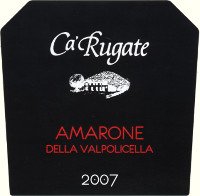
|
|
Amarone della Valpolicella 2007 |
|
| Ca' Rugate (Veneto, Italy) | |
| Grapes: Corvina (40%), Rondinella (30%), Corvinone (30%) | |
| Price: € 39.40 | Score: |
| This Amarone della Valpolicella shows an intense ruby red color and nuances of garnet red, little transparency. The nose denotes intense, clean, pleasing and refined aromas that start with hints of blackberry, black cherry and plum followed by aromas of violet, blueberry, vanilla, tobacco, chocolate, pink pepper and menthol. The mouth has good correspondence to the nose, a tannic attack and however balanced by alcohol, full body, intense flavors. The finish is persistent with flavors of blackberry, black cherry and plum. This Amarone della Valpolicella is produced with grapes dried for 5 months and aged for 30 months in cask. | |
| Food Match: Game, Roasted meat, Stewed and braised meat, Hard cheese | |
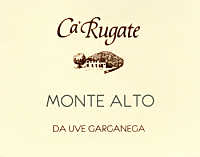
|
|
Soave Classico Monte Alto 2008 |
|
| Ca' Rugate (Veneto, Italy) | |
| Grapes: Garganega | |
| Price: € 8.90 | Score: |
| Soave Classico Monte Alto shows a pale golden yellow color and nuances of straw yellow, very transparent. The nose reveals intense, clean, pleasing, refined and elegant aromas that start with hints of apple, plum and almond followed by aromas of pear, pineapple, hawthorn, broom, chamomile, vanilla, grapefruit and medlar. The mouth has good correspondence to the nose, a crisp attack and however balanced by alcohol, good body, intense flavors, pleasing roundness. The finish is persistent with flavors of apple, plum and almond. Soave Classico Monte Alto ferments and ages in barrique for about 6 months. | |
| Food Match: Pasta with mushrooms, Mushroom soups, Roasted and stewed fish, Roasted white meat | |
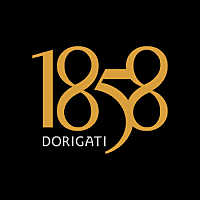
|
|
1858 2006 |
|
| Dorigati (Trentino, Italy) | |
| Grapes: Teroldego, Cabernet Sauvignon, Rebo, Gosen | |
| Price: € 47.00 - 1.5l | Score: |
| 1858 shows a deep ruby red color and nuances of ruby red, little transparency. The nose reveals intense, clean, pleasing, refined and elegant aromas which start with hints of black cherry, black currant and plum followed by aromas of violet, blueberry, vanilla, chocolate, tobacco, cinnamon, pink pepper, leather and eucalyptus. The mouth has good correspondence to the nose, a tannic attack and however balanced by alcohol, full body, intense flavors, agreeable. The finish is persistent with flavors of black cherry, black currant and plum. 1858 ages for 12 months in barrique followed by 6 months of aging in bottle. | |
| Food Match: Game, Roasted meat, Stewed and braised meat, Hard cheese | |
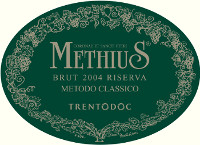
|
|
Trento Brut Riserva Methius 2004 |
|
| Dorigati (Trentino, Italy) | |
| Grapes: Chardonnay (60%), Pinot Noir (40%) | |
| Price: € 32.00 | Score: |
| Trento Brut Riserva Methius shows a pale straw yellow color and nuances of greenish yellow, very transparent, fine and persistent perlage. The nose reveals intense, clean, pleasing, refined and elegant aromas which start with hints of apple, banana and bread crust followed by aromas of pear, pineapple, hawthorn, yeast, plum, grapefruit, kiwi, hazelnut, butter and vanilla. The mouth has excellent correspondence to the nose, am effervescent and crisp attack, however balanced by alcohol, good body, intense flavors, pleasing roundness. The finish is very persistent with long flavors of banana, hazelnut and grapefruit. A part of the Chardonnay used for the base wine ferments in barrique. Trento Brut Riserva Methius referments in bottle on its lees for 5 years. | |
| Food Match: Roasted fish, Broiled crustaceans, Pasta and risotto with fish, Roasted white meat | |
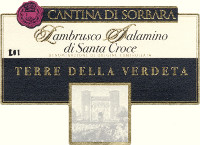
|
|
Lambrusco Salamino di Santa Croce Terre della Verdeta 2009 |
|
| Cantina di Sorbara (Emilia Romagna, Italy) | |
| Grapes: Lambrusco Salamino | |
| Price: € 3.80 | Score: |
| Lambrusco Salamino di Santa Croce Terre della Verdeta shows an intense ruby red color and nuances of purple red, little transparency, evident effervescence. The nose denotes intense, clean and pleasing aromas which start with hints of cherry, blackberry and violet followed by aromas of raspberry, blueberry and plum. The mouth has good correspondence to the nose, an effervescent and slightly tannic attack, however balanced by alcohol, good body, intense flavors, pleasing crispness. The finish is pretty persistent with flavors of cherry and blackberry. | |
| Food Match: Cold cuts, Pasta with meat, Sauteed meat | |
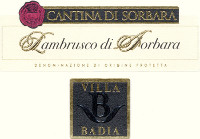
|
|
Lambrusco di Sorbara Villa Badia 2009 |
|
| Cantina di Sorbara (Emilia Romagna, Italy) | |
| Grapes: Lambrusco di Sorbara | |
| Price: € 3.80 | Score: |
| Lambrusco di Sorbara Villa Badia shows a brilliant ruby red color and nuances of cherry pink, moderate transparency. The nose reveals intense, clean and pleasing aromas which start with hints of cherry, raspberry and strawberry followed by aromas of rose, blueberry and violet. The mouth has good correspondence to the nose, an effervescent and slightly tannic attack, however balanced, good body, pleasing crispness. The finish is pretty persistent with flavors of cherry, raspberry and strawberry. | |
| Food Match: Meat appetizers, Pasta and risotto with vegetables, Sauteed meat | |
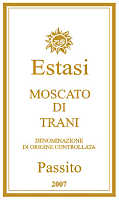
|
|
Moscato di Trani Estasi 2007 |
|
| Franco Di Filippo (Apulia, Italy) | |
| Grapes: Moscato Reale | |
| Price: € 21.00 - 500ml | Score: |
| Moscato di Trani Estasi shows a brilliant amber yellow color and nuances of golden yellow, transparent. The nose reveals intense, clean, pleasing, refined and elegant aromas that start with hints of raisin, apricot jam and honey followed by aromas of peach jam, banana, pineapple, lavender, almond, dried fig, date, linden, citrus fruits peel and broom. The mouth has good correspondence to the nose, a sweet and round attack, however balanced by alcohol, good body, intense flavors, pleasing crispness. The finish is persistent with flavors of raisin, honey, apricot jam and dried fig. Moscato di Trani Estasi ages in steel tanks. | |
| Food Match: Piquant cheese, Confectionery, Dried fruit tarts | |
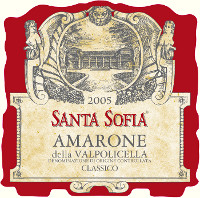
|
|
Amarone della Valpolicella Classico 2005 |
|
| Santa Sofia (Veneto, Italy) | |
| Grapes: Corvina (65%), Rondinella (30%), Molinara (5%) | |
| Price: € 31.50 | Score: |
| This Amarone della Valpolicella Classico shows an intense ruby red color and nuances of garnet red, little transparency. The nose denotes intense, clean, pleasing, refined and elegant aromas which start with hints of blackberry, plum and black cherry followed by aromas of violet, blueberry, vanilla, tobacco, chocolate, mace, leather and menthol. The mouth has good correspondence to the nose, a tannic attack and however balanced by alcohol, full body, intense flavors, pleasing roundness. The finish is persistent with flavors of blackberry, plum and black cherry. This Amarone della Valpolicella Classico ages for 36 months in cask followed by 12 months of aging in bottle. | |
| Food Match: Game, Roasted meat, Stewed and braised meat, Hard cheese | |
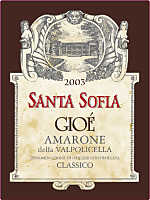
|
|
Amarone della Valpolicella Classico Gioé 2003 |
|
| Santa Sofia (Veneto, Italy) | |
| Grapes: Corvina (65%), Rondinella (30%), Molinara (5%) | |
| Price: € 43.00 | Score: |
| Amarone della Valpolicella Classico Gioé shows an intense ruby red color and nuances of garnet red, little transparency. The nose reveals intense, clean, pleasing, refined and elegant aromas which start with hints of blackberry, plum and dried violet followed by aromas of black cherry, blueberry, vanilla, licorice, mace, cocoa, tobacco, menthol and nail polish. The mouth has good correspondence to the nose, a tannic attack and however balanced by alcohol, full body, intense flavors, pleasing roundness. The finish is persistent with flavors of blackberry, plum and black cherry. Amarone della Valpolicella Classico Gioé ages for 36 months in cask, 12 months in barrique and 12 months in bottle. | |
| Food Match: Game, Roasted meat, Stewed and braised meat, Hard cheese | |
News |
|
In this section are published news and information about events concerning the world of wine and food. Whoever is interested in publishing this kind of information can send us a mail to our address.
|
AquavitaeReview of Grappa, Distillates and Brandy |
|
|
| Distillates are rated according to DiWineTaste's evaluation method. Please see score legend in the "Wines of the Month" section. |
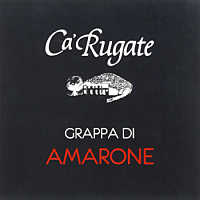
|
|
Grappa di Amarone |
|
| Ca' Rugate (Veneto, Italy) | |
| (Distiller: Distilleria Maschio Pietro) | |
| Raw matter: Pomace of Corvina, Corvinone, Rondinella | |
| Price: € 16.90 - 50cl | Score: |
| This grappa has a pale golden yellow color, limpid and crystalline. The nose reveals intense, clean and pleasing aromas of blackberry, plum, chocolate, vanilla, honey, hazelnut and tobacco, with almost imperceptible alcohol pungency. In the mouth has intense flavors, with perceptible alcohol pungency which tends to dissolve rapidly, good correspondence to the nose, pleasing roundness, balanced sweetness. The finish is persistent with flavors of blackberry, plum, honey and hazelnut. This grappa is distilled with a discontinuous steam operated alembic still and ages in cask for about 6-9 months. | |
Wine Parade |
|
|
| The best 15 wines according to DiWineTaste's readers. To express your best three wines send us an E-mail or fill in the form available at our WEB site. |
| Rank | Wine, Producer | |
|---|---|---|
| 1 |
| Aglianico del Vulture La Firma 2004, Cantine del Notaio (Italy) |
| 2 |
| Sagrantino di Montefalco Passito 2004, Adanti (Italy) |
| 3 |
| Blanc des Rosis 2006, Schiopetto (Italy) |
| 4 |
| Barolo Sorano 2004, Alario (Italy) |
| 5 |
| Barolo Bussia 2001, Prunotto (Italy) |
| 6 |
| Sagrantino di Montefalco 25 Anni 2005, Arnaldo Caprai (Italy) |
| 7 |
| Collio Bianco Col Disôre 2004, Russiz Superiore (Italy) |
| 8 |
| Brunello di Montalcino Progetto Prime Donne 2004, Donatella Cinelli Colombini (Italy) |
| 9 |
| Sangiovese di Romagna Superiore Riserva Thea 2005, Tre Monti (Italy) |
| 10 |
| Arkezia Muffo di San Sisto 2004, Fazi Battaglia (Italy) |
| 11 |
| Aglianico del Vulture Il Repertorio 2006, Cantine del Notaio (Italy) |
| 12 |
| Sagrantino di Montefalco Collepiano 2003, Arnaldo Caprai (Italy) |
| 13 |
| Trento Brut Riserva Methius 2004, Dorigati (Italy) |
| 14 |
| Barolo Cannubi Boschis 2005, Sandrone (Italy) |
| 15 |
| Chianti Classico Riserva 2005, Capannelle (Italy) |
| |||||||
Privacy Policy | |||||||


| Copyright © 2002-2024 Antonello Biancalana, DiWineTaste - All rights reserved |
| All rights reserved under international copyright conventions. No part of this publication and of this WEB site may be
reproduced or utilized in any form or by any means, electronic or mechanical, without permission in writing from DiWineTaste. |